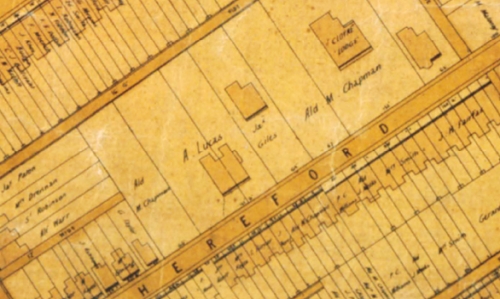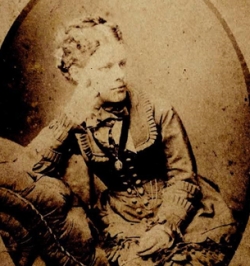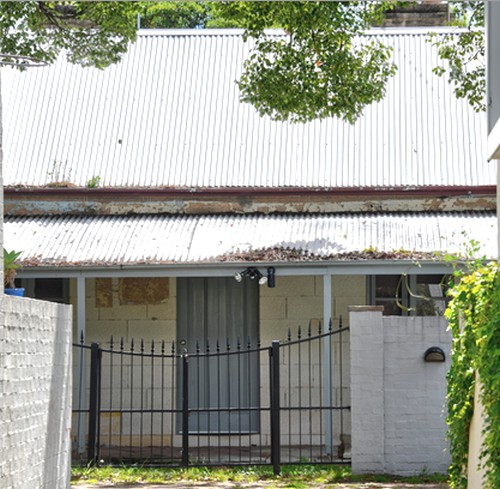Known locally as ‘the old farmhouse’, this building has survived for just on 150 years, making it one of the oldest in Forest Lodge/Glebe. The single-storey stone ‘handsome villa’ was newly built in June 1859 when J R Harrison advertised it for sale together with vacant land and his own weatherboard home (‘tastefully papered’ with ‘massive marble mantelpieces’, set in a garden with established shrubs and fruit trees). The hillside properties, each 1/3 of an acre, were ‘romantically situated’ with panoramic views from Annandale across the Toxteth Estate and Johnson’s Bay to the University of Sydney paddocks. The city was within easy walking distance via the new Pyrmont Bridge Rd.
Both houses were sold. Harrison’s home was sold to artist Joseph Fowles who occupied it briefly. On the vacant blocks separating the houses, Michael Nason Chapman later built Cloyne Lodge. Chapman became the street’s biggest landowner. In July 1859 Harrison advertised for sale his building materials, furniture, cows, poultry and horse in preparation, he said, for a move to ‘the interior’. The auctioneer arranged for omnibuses to leave Wynyard St in the city every five minutes taking potential purchasers to Hereford St.
James Robert Harrison (1813-70) was an English-born grocer and wine and spirit merchant. His Charlotte Place stores on Church Hill stocked all manner of sundries including cart wheels, drapery, crockery, sheepskins and office furniture. Many of his customers were hotel keepers. In 1854 he married French-born artist Marguerite Clementine Romansson (1816-87). The couple lived at Nithsdale Cottage in Elizabeth St where Madame Romansson ran a Ladies’ Seminary and where a son was stillborn in 1851 and Clementine Ada was born and died in 1854. They subsequently had two other daughters: Ellen (1855-76) and Clementine Emily Margaret (1857-1937).

After 1845 Harrison speculated in property, especially Crown Land bought cheaply, in areas from Oatley to Lane Cove, Coogee to Port Curtis, Homebush to Sydenham to Vaucluse. On 1 July 1855 he bought eight Glebe allotments totalling nearly three acres and a year later, announcing that he was ‘retiring to the country’, advertised his Nithsdale Cottage furniture for sale. Some time after 1859 the Harrisons settled in NZ where their younger surviving daughter Clementine Mellsop MA became Principal of Wanganui Girls College.

The first buyer of what was later numbered 75 Hereford St was Portsmouth-born William Buchanan (1830-98) who married Mary Morris in May 1858. Buchanan entered the NSW Public Service in 1852. By 1863 he was one of 26 Post Office clerks on an annual salary of £300. He was promoted to Chief Clerk, then Mail Branch Superintendent, and by 1875 was one of the colony’s three Postal Inspectors on £400 p.a. with an equipment allowance and per diems.
The Buchanans christened the house Camber Cottage. Born there were Norah Wellbank (1860- 1951), Frank Walton (1861-1943), Kate Hannah (1863-4), Mary Ellen (1865-1952), Angus McLeod (1867-1956), Kate Winifred (died aged 5 months in 1868), Norman McLeod (1869-1961) and Alec McLeod (1871-2).
Mary’s sister Louisa Eagar gave birth to a son at Camber Cottage in 1861 and their mother Ann Morris died there in 1866. William was executor of the will of his brother-in-law Nicholas Henry Eagar who died in Gladesville Asylum in 1872.
In 1877 Mary Buchanan petitioned for divorce on the grounds of adultery. The case was highly publicised because it was one of the first heard behind closed doors. The co-respondent was Louisa and Nicholas’s daughter Kate Ellen Eagar who had been educated in London. Mary was given custody of her four surviving dependent children and moved to Victoria. William wed his niece by marriage and moved to Katoomba. Kate Buchanan accompanied William on his horse-and-buggy postal inspections through mud and bad weather, taught piano, and ran a boarding house. She outlived her husband by 30 years. In old age she recalled the scrublands of Sydney University.
Camber Cottage’s next occupant was James Giles who renamed it Midhurst, probably a family connection with the market town in Sussex; the Woollahra home of his older brother Francis was Midhurst Villa. Francis Giles was a retailer in Denison House in George St near the GPO, his store’s motto: ‘Variety, Novelty and Elegance’. Buyers in London and Paris shipped back silk, lace, cashmere and mohair mantels and shawls, yachting jackets, the Lola Montez stay and corsets for maids and children, beribboned hats and bonnets, plus other quality clothing and household goods. A Mourning Department specialised in articles for the bereaved. In 1865 Francis Giles went into partnership with another retailer, John Thompson. Thompson and Giles became Sydney’s leading department store with a mail order business for country customers. James Giles joined the firm.
Emma and James Giles (who married by special licence in 1856) had moved into Midhurst by the time their youngest child Annie Maude was born on 14 October 1877. Aged 3½ she died there in 1881; Emma Louisa, the eldest, died there aged 29 in 1886. Both were buried in Waverley Cemetery. Their siblings were James William Hill (1859-1914), Constance Helen (1861-1919), Agnes Amelia (1863-1945), Charles Edward Hill (1867-1943), Thomas Arthur Hill (1869-1945), Charlotte Edith (1871-1940) and Caroline Ethel (1874-1925).
After Francis Giles’ death in 1888 and that of the senior partner the next year, John Thompson jnr disposed of the business in 1892 and joined David Jones, while the head of the silk department, John McDowell, set up his own drapery.
James Giles retired from retailing and moved from Forest Lodge to Meroo Meadow near Nowra where he bought a 300-acre dairy farm which he renamed Forest Lodge. He died on Christmas Eve 1906 and his body was taken to Waverley Cemetery for burial with his two deceased daughters and wife Emma née Hill who had died the year before. James had at least three career changes. He began his working life as a master seafarer.
Houses were known first by name, then by number which changed with building density. It was not until ca 1908 that 75 Hereford St was given its present address. By 1892 it had been re-christened a third time. The extended family of its next occupants adds an extra element of confusion. Involved are four men called Wykes Norton, two women known as Nellie Norton, two men called Michael Nason Chapman and four houses named Yelvertoft.

Yelvertoft was the Yorkshire birthplace of Wykes Norton, a spirit merchant turned butcher who had died in Bay St Glebe in 1870. (His widow Elizabeth died at Lyndhurst in Brougham St in 1886.) Wykes Norton jnr changed Midhurst to Yelvertoft. He had already given the name to a house on the other side of Hereford St, built with two others – Kettering and Hazelbrook – in 1885. Kettering and the first Yelvertoft were rented out while Wykes jnr and his wife moved into Hazelbrook near Cross St. (An early tenant of Forest Lodge’s first Yelvertoft was Julius Buddee jnr whose father, a music professor, lived at the Glebe Point Rd end of Hereford St. Julius Buddee snr had been farewelled in Melbourne with a concert featuring Nellie Melba. He died at Cremona in Boyce St in 1890. There was also a Yelvertoft in Randwick owned by Wykes jnr’s brother Alfred Benjamin Norton.)
Wykes Norton jnr was born in Maitland. Originally a draper’s assistant, he made a living as a professional photographer. He also speculated in mining, including an unsuccessful bid to dig for natural gas in Ultimo. On Christmas Eve 1880 he married Ellen Chapman, the youngest daughter of Michael Nason Chapman, ex-Mayor of Sydney, long-serving Glebe alderman and the owner of a great deal of property including much of Hereford St. The ceremony was held at Michael’s home Cloyne Lodge (named for his birthplace in Ireland) and the Nortons’ first three children were born there: Nellie Chapman (1881-1954), Wykes Strange Chapman (1883-1947) and Leonard Gordon Chapman (1885-9). Kate Elizabeth Chapman (1887-1966) was born at Hazelbrook and Effie Leonard Chapman (1892-1972) at the new Yelvertoft, a month before the death of her 52-year-old father who was buried in the Chapman family vault at Waverley.
Wykes’ widow was left with the task of selling off his George St studio showcases, developing troughs and other photographic equipment. She moved to the first Forest Lodge Yelvertoft with her young children but had returned to the second by 1907 following the death of her father the previous year. 75 Hereford St was the venue for the 1909 wedding breakfast of Ellen’s oldest child Nellie and Harold James Coffill after their marriage at St John’s, the event catered by Sargents Ltd in a marquee on the lawn. The couple’s first daughter was born at Yelvertoft the next year.
The Chapman family’s Forest Lodge holdings broke up during the First World War. Ellen Norton died at Yelvertoft in 1915 and was buried in the Chapman family vault at Waverley. She and her children were left comfortably off by her father’s will but the family patriarch bequeathed most of his property and wealth to his namesake grandson, Ellen’s nephew. A JP and Glebe councillor, the second Michael Nason Chapman lived in Cloyne Lodge before moving to Phoenix Lodge (rebuilt on the site of another Cloyne Lodge) at Faulconbridge where he entered local politics. The Cloyne Lodge site at Forest Lodge was then used as a warehouse for Lackersteen & Co sauce manufacturers before it became an Area Training and Drill Hall, headquarters of the 55th battalion with an officers’ mess and storage for military equipment. A dance in 1923 raised money towards the upkeep of the Glebe War Memorial, but not all the locals were happy. According to one alderman the place was a beer garden, a gambling hell, its sanitary conditions a menace to the district. The young soldiers used ‘shocking language’ and had ‘developed the playful habit of heaving stones and bricks through the windows of surrounding houses’.
Ellen Norton’s children remained at number 75 for about a year after her death. Wykes Strange Norton, in partnership with his brother-in-law Harold Coffill and encouraged by wartime shortages of manufactured goods, used the house as the contact point for orders of overhead cash-carrying systems for shops before branching out on his own as a maker of wooden cricket bats and stumps and book trucks on wheels. Wykes Strange was a Sydney representative for the British Birth Control Society before moving to Melbourne where he became a company director with Rauch and Norton food and pharmaceutical makers and traders. His son Wykes William Robey Norton, a pilot in the Second World War, was shot down over Holland in 1942. In civilian life the fourth Wykes Norton was an industrial chemist.
Nellie and Harold Coffill moved to Carlton Mansions on Glebe Point Rd. Kate and Effie Norton lived in a new Yelvertoft at Double Bay before they married: Effie in England to serviceman Henry Osborne in 1920 and Kate to Stanley Ernest Johnston in Glebe the next year.

After 75 Hereford St was vacated by the Norton family, zoologist Edward Francis ‘Frank’ Hallmann (1880-1939) was its next occupant. His German-born mother Margherita, a Hinton vigneron, died there in 1921. Born and educated at Singleton, Frank was a probationary pupil teacher at Mulbring before transfers to Camperdown, Albion St, West Wyalong, Junee, Darlinghurst, Fort St, Neutral Bay, Sydney Boys High and North Sydney Boys High. He graduated BA BSc from Sydney University and in 1912 was awarded a Linnean Macleay Fellowship. Following his death his library of scientific and radical books was donated to the institution.
In 1904 he married Lillie Violet Christison (1882-1965). Their son Frank Malcolm was born in Arundel St in 1907 and educated at Glebe Public School, while his sister Merle Canas attended Forest Lodge School. In 1925 he won a mathematics medal at the Technical High School where fellow award-winners were Morton Herman, later a prominent architect, and William Pidgeon (the cartoonist ‘Wep’) who won a prize for drawing and who remained a lifelong friend. After leaving school Frank worked in the General Drafting Branch of the Lands Department before transferring to the Dubbo Land Board Office. He studied law while in the Survey Drafting Branch of the Land Titles Office, graduating LLB in 1949. After retiring from the Public Service, Frank lectured in survey and property law at UNSW. A champion chess player and a first-class mathematician, he died in 1975. Frank Hallmann’s standard 1973 textbook Legal Aspects of Boundary Surveying as Apply in New South Wales was republished in 2008.









There are no comments yet. Please leave yours.